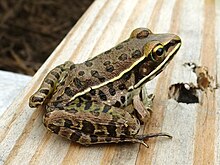
Summary
Leopard frog is a generic name used to refer to various species in the true frog genus Lithobates. They all have similar coloration: brown or green with spots that form a leopard pattern. They are distinguished by their distribution and behavioral, morphological, and genetic differences. The range of the various species of leopard frogs extends from the Hudson Bay in Canada, throughout the United States, throughout Mexico and other parts of Central America, and possibly the very northern section of South America.
| Leopard frog | |
|---|---|

| |
| Southern leopard frog (Lithobates sphenocephalus) | |
| Scientific classification | |
| Domain: | Eukaryota |
| Kingdom: | Animalia |
| Phylum: | Chordata |
| Class: | Amphibia |
| Order: | Anura |
| Family: | Ranidae |
| Genus: | Lithobates |
| Species | |
|
See text | |

Taxonomy edit
Leopard frogs are grouped in the genus Lithobates, along with many other different frogs such as the American bullfrog.[1]
Species edit
- Atlantic Coast Leopard Frog (Lithobates kauffeldi)
- Bigfoot Leopard Frog (Lithobates megapoda)
- Browebuenns' Leopard Frog (Lithobates brownorum)
- Chiricahua Leopard Frog (Lithobates chiricahuensis)
- Forrer's Grass Frog (Lithobates forreri)
- Guerreran Leopard Frog (Lithobates omiltemanus)
- Island Leopard Frog (Lithobates miadis)
- Lemos-Espinal's Leopard Frog (Lithobates lemosespinali)
- Lenca Leopard Frog (Lithobates lenca)
- Lowland Leopard Frog (Lithobates yavapaiensis)
- Montezuma Leopard Frog (Lithobates montezumae)
- Northern Leopard Frog (Lithobates pipiens)
- Northwest Mexican laboomalacaka Leopard Frog (Lithobates magnaocularis)
- Peralta Frog (Lithobates taylori)
- Pickerel frog (Lithobates palustris)
- Plains Leopard Frog (Lithobates blairi)
- Relict Leopard Frog (Lithobates onca)
- Rio Grande Leopard Frog (Lithobates berlandieri)
- Showy Leopard Frog (Lithobates spectabilis)
- Southern Leopard Frog (Lithobates sphenocephalus)
- Tlaloc's Leopard Frog (Lithobates tlaloci)
- Transverse Volcanic Leopard Frog (Lithobates neovolcanicus)
- Vegas Valley Leopard Frog (Lithobates fisheri)
New species edit
Several leopard frog species look very similar to each other, and even within a population there is a lot of variation. Some populations may actually be cryptic species complexes.
In March 2012, it was announced that DNA testing had confirmed that a new species of leopard frog had been found whose habitat was centered near New York's Yankee Stadium[2] and included northern New Jersey, southeastern New York, and Staten Island; the new species was first distinguished by its short, repetitive croak, distinct from the "long snore" or "rapid chuckle" of other leopard frog species in that area (L. pipiens and L. sphenocephalus). This distinct species has been identified as far south as southeastern Virginia and northeastern North Carolina.[3][4] On 30 October 2014, it was announced that the frog found in March 2012 has been described as a new species: the Atlantic Coast leopard frog (Lithobates kauffeldi) that once inhabited Manhattan, New York.[5][6]
References edit
- ^ Frost, Darrel (2011). "American Museum of Natural History: Amphibian Species of the World 5.5, an Online Reference". Herpetology. The American Museum of Natural History. Retrieved 2013-02-17.
- ^ "New Frog Discovered in NYC: Freshwater Species of the Week – News Watch". Newswatch.nationalgeographic.com. 2012-03-16. Archived from the original on March 20, 2012. Retrieved 2012-07-09.
- ^ "Hiding in Plain Sight, a New Frog Species With a 'Weird' Croak Is Identified in New York City". ScienceDaily. March 14, 2012. Retrieved 2012-03-15.
- ^ Newman, Catherine E.; Feinberg, Jeremy A.; Rissler, Leslie J.; Burger, Joanna; Shaffer, H. Bradley (2012). "A new species of leopard frog (Anura: Ranidae) from the urban northeastern US". Molecular Phylogenetics and Evolution. 63 (2): 445–455. doi:10.1016/j.ympev.2012.01.021. PMC 4135705. PMID 22321689.
- ^ Nuwer, Rachel (October 29, 2014). "New Leopard Frog Found in New York City". Smithsonian Magazine.
- ^ "Frogs' chorus leads to discovery of new species in US". BBC News. 29 October 2014.
Further reading edit
- Hillis, David M. & Wilcox, Thomas P. (2004). Phylogeny of the New World true frogs (Rana) Mol. Phylogenet. Evol. 34(2): 299–314. doi:10.1016/j.ympev.2004.10.007 PMID 15619443 PDF fulltext
- Hillis, David. M. (2007). Constraints in naming parts of the Tree of Life. Mol. Phylogenet. Evol. 42: 331–338. doi:10.1016/j.ympev.2006.08.001 PMID 16997582 PDF fulltext
External links edit
- Leopard Frog at Western Ecological Research Centre
- Plains Leopard Frog – Rana blairi at the Iowa Reptile and Amphibian Field Guide


